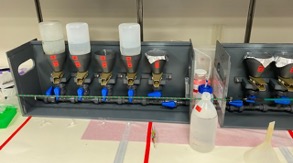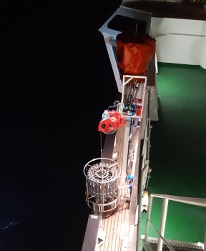(english version below)
Es ist der 1. Januar 2022. Für uns beide ist es das erste Mal Silvester auf einem Forschungsschiff. Weit entfernt von zu Hause, nämlich in der Karibik, haben wir nun zu Silvester nach getaner Arbeit also ganze fünf Mal auf das neue Jahr angestoßen, denn wir haben viele verschiedene Nationen an Bord. Aber wie das so ist, auf einem Forschungsschiff geht die Arbeit auch an den Feiertagen weiter. Aktuell befinden wir uns auf dem Weg zum Panama-Kanal, um die FS Sonne wieder in ihr wichtigstes Forschungsgebiet, den Pazifik, zu überführen. Auf dem Weg fahren wir immer mal wieder langsam, um mit dem Katamaran nach Sargassum-Algen oder Makroplastik zu fischen. Der Kranzwasserschöpfer hat aktuell eine Pause, denn für den Atlantik haben wir diese Art von Stationsarbeit beendet. Zeit für eine Retrospektive der letzten 3,5 Wochen.
Als Teil der Arbeitsgruppe von Professorin Dr. Anja Engel am GEOMAR beschäftigen wir uns mit gelöstem und partikulärem organischem Material in der Wassersäule: Welche Organismen sind im Wasser, welche organischen Substanzen produzieren sie und wie werden diese Substanzen in der Wassersäule verarbeitet. Diese Informationen sind wichtig, um den Kohlenstoffkreislauf im Meer zu verstehen. Als Teil dieser Arbeit haben wir zehn nun Tag und Nacht fast 4300 Liter an Wasserproben aus dem Kranzwasserschöpfer genommen und davon etwa 3400 Liter Seewasser auf über 5000 Filterpapieren filtriert. 7776 Stunden lang haben wir Seewasser inkubiert (natürlich parallel); also bei bestimmten Temperaturen Experimente durchgeführt, um herauszufinden, wieviel und wie schnell die verschiedenen Organismen organisches Material produzieren oder verarbeiten.

1600 Meter hat das FastOcean APD, das mithilfe von Lichtblitzen die photoynthetische Aktivität von Mikroalgen misst, vertikal in den oberen 100 Metern Wassersäule des tropischen Atlantiks zurückgelegt. 24 Mal bis jetzt hat der Katamaran den Atlantik durchforstet, um Makroplastik aus dem Oberflächenwasser zu fischen und mehr als hundert Stunden wurden diese Proben sortiert. Am Ende dieser Expedition, und wenn all diese Proben zu Hause im Labor gemessen worden sind, werden wir wertvolle Informationen zum Kohlenstoffkreislauf im tropischen Atlantik gewonnen haben und wie insbesondere der Kohlenstoffkreislauf sich auf dem Weg vom produktiveren Ostatlantik in den weniger produktiven Westatlantik verändert. Diese Informationen sind auch dafür wichtig, um zu verstehen, wie der Klimawandel zukünftig den Kohlenstoffkreislauf in diesen Breiten beeinträchtigen wird. Ultimativ wird damit das Verständnis zur Produktion und der Aufnahme von Kohlenstoffdioxid deutlich verbessert werden.
Noch sind wir nicht mit unserer wichtigen Arbeit fertig. Wir werden sehen, wieviel pazifisches Seewasser im neuen Jahr auf dieser Forschungsfahrt durch unsere Filtrationsgestelle laufen wird, wie viele Filterpapiere wir noch verbrauchen werden, oder wieviel Plastik uns noch in die Netze gehen wird.
Wir grüßen aus der Karibik,
Helmke und Sandra
Happy New Year!
It’s January the 1st, the first day of 2022. This is the first time that we are on a cruise for new year‘s eve. We toasted in total five times to the new year because we have people from many different countries on board far away from home, namely in the Caribbean Sea. However, we are still here to work, so even today, the work goes on. Currently, we are on our way to the Panama Canal to cross over to the Pacific, where the RV Sonne is taking up work again in its‘ important research area. Once in a while, we are slowing down to search for Sargassum or macroplastic with the katamaran. The water sampling rosette is currently not in action, since we finished all related station work in the Atlantic. Now it’s time to recall the past 3.5 weeks.
As part of the working group of Professor Dr. Anja Engel at GEOMAR, we are looking at dissolved and particulate organic material in the water column: which organisms are in the ocean, which organic substances are produced, and how are these substances cycled in the water column. These information are important to understand the carbon cycle in the ocean. We ten took 4300 litres of seawater from the water sampling rosette, of which we filtered about 3400 litres through more than 5000 filters both day and night. We incubated seawater for about 7776 hours in total in parallel at different temperatures to understand how much and how fast the different organisms produce organic material and how they degrade it.
The FastOcean APD traveled 1600 metres through the upper 100 metres water column measuring photosynthetic activity of microalgae with the help of flashs of light. The catamaran trawled 24 times through the Atlantic to check for miacroplastic, and sampels of it were sorted for more than 100 hours. At the end of this expedition and when all samples will be analyzed in the lab back at home, we will have a very valuable dataset on carbon cycling in the tropical Atlantic. The information that we are collecting will be especially helpful to understand how the cycling of carbon is changing from the productive Eastern Atlantic to the less productive Western Atlantic. This information is important to learn how climate change may affect carbon cycling in these latitudes. Ultimately, we will improve the understanding of the production and the uptake of carbon dioxide in and from the ocean.
As yet, we are not done with this important work. We are excited to see how much Pacific seawater will go through our filtration racks, how many more filters we will take home to analyse and how much plastic we will be able to collect to learn how plastic is changing microbial interactions in the ocean.
With regards from the Caribbean,
Helmke and Sandra
